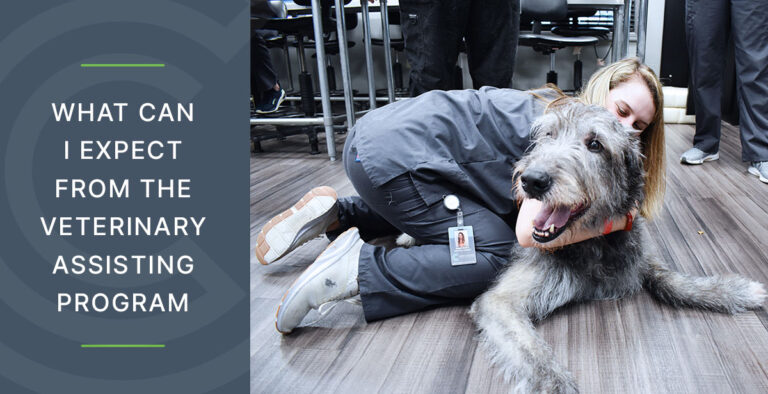Are you considering a career caring for the world’s furry (and sometimes not so furry) friends? If so, you might be wondering what being a student in a veterinary assistant program will be like. To get you ready for a future that is all about helping pets and the people who love them, we’re exploring the ins and outs of veterinary assistant programs and the things you need to know. But first, let’s talk about what role a veterinary assistant actually plays in a veterinary practice.
The Role of a Veterinary Assistant
First and foremost, let’s establish that veterinary assistants play a critical role in any veterinary practice and provide hands-on assistance to veterinarians including taking vital signs, drawing blood samples, cleaning kennels, and preparing medications. Veterinary assistants are also responsible for caring for animals during their time in the office, providing food and water as needed, and ensuring the safety and comfort of all patients. In addition, veterinary assistants often provide emotional support to clients and help them understand the treatment their pet is receiving. It’s easy to see why empathy, compassion, and excellent communication skills are essential traits for a veterinary assistant. But veterinary assistants must also be able to master the clinical aspects of the job.
What Will I Learn in a Veterinary Program?
Most veterinary assistant programs combine classroom and clinical instruction in a variety of areas. You can typically expect program curriculum to cover:
- Surgical preparation to assist technicians and doctors with preparing animals for elective and emergency surgeries.
- Pharmacology, including basic dosage calculations and drug uses, reactions, and routes.
- Preparation of various laboratory procedures and testing protocols such as microscopic fecal exam and skin scraping, DTM, urine specific gravity and sediment exam, and staining techniques.
- Proper animal restraint techniques for treatment, procedures and exams such as blood draws, rectal exams, ear cleaning, etc.
- Effective client communication and education, vaccine protocols, and preventions.
- Administrative responsibilities such as filing patient records, faxing, and communication with other veterinary offices.
- You’ll learn important safety protocols such as how to handle hazardous materials properly, ways to prevent the spread of disease, and how to react in emergencies.
The Benefits of Becoming a Veterinary Assistant
If job security is important to you, becoming a veterinary assistant might be a great option. According to the Bureau of Labor Statistics, the job market for veterinary assistants is growing at a much faster than average rate and is expected to add a whopping 20,000 new jobs by 2031. Let’s face it, people love their pets!
Certifications and Education Requirements for Veterinary Assistants
Veterinary assistants are valuable members of any animal care team. They often play a dual role in an animal practice as they provide both patient care and administrative support. The educational requirements vary depending on the employer and the state you’re in, but typically require completion of an accredited veterinary assistant program. Most programs require at least a high school diploma or equivalent and many employers prefer to hire veterinary assistants with an AVA (Approved Veterinary Assistant) certification. Program lengths can vary but usually range between 10 – 24 months in general.
In addition to the educational requirements, some employers will require that you have experience with animals and demonstrate good communication skills. That can include anything from volunteer work in an animal shelter to working in a veterinary clinic. You should also be prepared to demonstrate proficiency in medical terminology and technical skills related to animal care.
What to Look for in a Veterinary Assisting Training Program
Once you’ve made the decision that veterinary assisting is the right path for your future, now it’s time to find the right training program. You’ll want to ask several questions:
- Does the program offer comprehensive coverage of all aspects of veterinary assisting? This should include training in animal handling, diagnostics, medical terminology, and basic nursing skills. The program should also cover ethical guidelines, laws and regulations, and safety protocols associated with working in a veterinary setting.
- Will there be an opportunity to practice hands-on clinical skills in a laboratory setting through internships or externships at local veterinary clinics or animal shelters? Gaining real-world experience working with animals will help you hit the ground running once you complete the program.
- Ask questions about the program’s faculty, student resources, and alumni network. Doing your research will ensure that you’re getting the best education possible and that you have access to the necessary support during and after your program.
- How long is the program? If you’re looking for a fast-track career in veterinary assisting, you’ll want to look for a program that gets you there quickly and still delivers a quality education.
Deciding to pursue a future that is all about helping animals takes a special person. After all, pets have the ability to change our lives. What better way to earn a living than working to improve the lives of pets everywhere? If you’d like to learn more about a career as a veterinary assistant, check out the veterinary assistant program at Caris College. With a 10-month accelerated program and 150-hour externship, Caris can help you get the hands-on training and skills you need to become a veterinary assistant. Contact us now for more information.
More on a vet tech program
